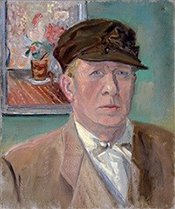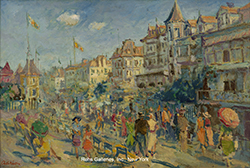BIOGRAPHY - Lucien Adrion (1889 - 1953)

Lucien Adrion’s early life mirrors the tumult of early 20th century Europe. Born on May 25, 1889, in the city of Strasbourg, which was then part of Germany. His art education began when he was apprenticed as a technical draughtsman in 1905. Three years later he moved to Paris to work as a fashion illustrator. Once there however, he spent only a brief time creating fashion illustrations and instead, set out for London. Almost nothing is known about his time in London although it may have attracted the young designer’s interest because of its reputation as a center of professional education for artists interested in more commercial applications of the visual arts.
After spending time in London, Adrion moved on to Munich. Was he curious about the newly formed New Artists Association Munich (Neue Künstlervereinigung München), whose membership included many of the most forward-looking artists of the day? Beginning in 1909, the exhibitions of the NKVM routinely traveled to other cities in Germany. Assuming that he was in contact with friends and family from Strasbourg, Adrion may well have known about these arts communities in the German-speaking regions of Europe. His later connection with the Berlin Secession group suggests that he was well aware of the German and Austrian Secessionist movements early in the century. [i]
Everything changed on July 28, 1914 when the Archduke Franz Ferdinand of Austria and his wife Sophie were assassinated by the 19-year-old Bosnia nationalist Gavrilo Princip during a visit to Sarajevo. As a result, Austria-Hungary declared war on Serbia and then on Russia, who supported the Serbians. This ignited a chain reaction among various allied nations including Germany, France, Great Britain, and Turkey. Adrion appears to have traveled to Paris at some point in 1915 where he painted a rather large canvas of the Paris Stock Market building (La Bourse), but he would undoubtedly have been asked to leave in accordance with France’s requirement that all foreign nationals return to their home countries during the war.
Back in Germany, Adrion moved to Berlin where he worked with the engraver Hermann Struck (1876-1944) who was affiliated with the Berlin Secession movement. [ii] Like many others, Struck had studied at the Berlin Academy of Fine Arts, but was not allowed to teach there because he was Jewish. In 1904, he became a member of the Berlin Secession group, which did not endorse such intolerant practices. Struck was also the author of Die Kunst des Radierens: Ein Handbuch, (The Art of Etching: A Handbook), a seminal text on etching. His students included not only Adrion, but Max Liebermann, Marc Chagall, and Lovis Corinth.
During the war Adrion served in the German army; military service was compulsory for all German citizens. Struck himself volunteered to serve and was assigned to work as a military artist. Perhaps Adrion might have done similar work since he was affiliated with Struck at the time. At the end of the war, Adrion returned briefly to Strasbourg where he would resume painting more regularly. In the next few years, he would travel to Italy, where he spent some time in Naples, and eventually moved back to Paris. [iii]
By 1920, Adrion had settled in Montparnasse, perhaps at La Ruche (The Beehive), the complex of inexpensive studios on the Passage Dantzig where many artist refugees from Eastern Europe found affordable accommodations. [iv] Among those who Adrion befriended were Chaim Soutine, Michel Kikoine, and Pinchus Kremegne, all of them Jewish immigrants from Belarus and Lithuania. Marc Chagall was also a neighbor during this period. The notoriety of La Ruche may be best illustrated by an apocryphal story told by Kremegne: with only three Russian rubles to his name and almost no knowledge of French, he claimed to have arrived at the Paris train station and simply said “Passage Dantzig”. That got him to where he needed to go. In the decade of the 1920s, La Ruche had 110 studios filled with painters, sculptors, poets, playwrights, and rabble-rousers; it has been restored today and houses 50 studios.
Adrion immediately began painting cityscapes featuring well-known locations such as the Luxembourg Gardens and the Grand Palais. By 1921, he had his first solo exhibition at the Galerie Chéron, where Foujita and Modigliani had also exhibited. The art dealer Georges Chéron would become Adrion’s representative shortly thereafter. In 1922, Adrion visited Algeria where he spent some time in the market town of Bou Saâda on the northern edge of the Sahara, painting the village streets lined with date palms as well as the commercial bustle of the local market. Back in France a year later, he would make shorter painting trips to Deauville as well as the countryside surrounding Paris.
Of particular interest are Adrion’s paintings of the 1924 summer Olympics in Paris (VIII Olympiad). He captured the marathon race through the city not as a large group of runners, but as the select few finalists run up the steps leading to the basilica of Sacre Coeur in Montmartre. Off to one side, photographers with their large format cameras on tripods capture the moment while officials crouch near the finish line to document the winner.
As Adrion settled into life in Paris, he began to exhibit his paintings at the Salon des Indépendants, where he had his first major exhibition in 1926; and at the Salon d’Automne, and the Salon des Tuileries. This would continue up until 1941 when the Germans occupied Paris.
The decade of the 1930s opened with an extended trip to the south of France. Paintings from Cannes offer scenes of beaches and sunbathers, while the fishing boats take center stage in the canvases from St. Tropez. Not surprisingly, the images of Nice illustrate the grand Promenade des Anglais as well as the new and glamorous swimming pool at the Hotel Negresco. Later in the decade, Adrion traveled to Brittany and Normandy, painting the beaches at Deauville and the cliffs at Etrétat as well as many small villages of the countryside.
Somewhat more unusual, Adrion painted an airport in 1935. The precise location is unknown, but there appears to a good-sized terminal in the background and a large, well-paved runway. It may be that this was the airport at Orly, which opened in 1932 and was quite close to Adrion’s home in suburban Bièvres. Adrion moved to Bièvres in 1935, probably shortly after he married and started a family.
Trips to Monte Carlo and Cote d’Azur in 1937 and then to England in 1938 produced an array of beach paintings and seaside promenades, albeit in two very different climates. And as always, there were paintings of Paris. As the political tensions of the world grew more worrisome, Adrion’s canvases focused increasingly on his local environment in Bièvres. One in particular shows a large, beautiful garden at his own home, suggesting that he was living a comfortable life.
The Nazi occupation of Paris began in the summer of 1940, and for the next few years, Adrion’s work is largely limited to his immediate neighborhood. In 1943, he moved to Villiers-sur-Marne, a small town to the east of Paris that was more modest than Bièvres. He and his family would remain there until October 1945, when they moved back to the city, living in the 16th arrondissement in the working class neighborhood on the west side of the Seine. Later they would return to the heart of Paris in the 9th arrondissement.
After the end of the war, Adrion again traveled to Normandy, particularly to the beaches at Deauville in 1948, but in general he seems to have stayed closer to home, painting the flowering chestnut trees of Paris and the view from his own apartment. There was also an increase in the number of still life paintings during these years. A self-portrait from 1945 shows a seemingly healthy middle-aged man with a still life painting behind him. Although the image is characterized by an almost pastel palette of colors, the artist’s expression is somewhat bleak. The war years were undoubtedly difficult. Adrion would die in Paris on August 9, 1953, at age 64.
Janet Whitmore, Ph.D.
Selected Museums
Musée d’Art Moderne et Contemporain, Strasbourg, France
Neue Pinakothek, Munich
Van Gogh Museum, Amsterdam
Notes
[i] The first Secessionist group was based in Vienna, where students and some of the faculty at the government-sponsored art school walked out in protest in 1897. Led by Gustave Klimt, they immediately formed the Vienna Secession group and began to exhibit independently and publish the journal, Ver Sacrum, which advocated for the unity of all arts and freedom of expression. For more information see Christian Brandstätter, Daniela Gregory and Rainer Metzger, Vienna 1900 Complete, (New York: Thames and Hudson, 2018). trans. David Henry Wilson.
[ii] The Berlin Secession group was founded in 1898 in opposition to the restrictions imposed on art by Kaiser Wilhelm II. Hermann Struck was a part of this group. Die Kunst des Radierens: Ein Handbuch was published in Berlin by Paul Cassirer in 1920.
[iii] Adrion painted a small oil painting of the Castello Arragonese on the island of Ischia in the Bay of Naples between 1919 and 1920, thus documenting his time there immediately following the war.
[iv] The building known as La Ruche was originally designed by Gustave Eiffel as a wine rotunda for 1900 Exposition universelle. After the Expo, the sculptor Alfred Boucher (1850-1934) had it re-constructed as a permanent structure for artists’ studios. The circular shape gave rise to the name The Beehive. The list of artists who lived and/or worked there is extensive. It includes Fernand Léger, Jacques Lipshitz, Robert Delauney, Amedeo Modigliani, Constantin Brancusi, Diego Rivera, and Max Pechstein to name just a few of the most famous individuals. For more information, see: https://www.laruche-artistes.fr/

